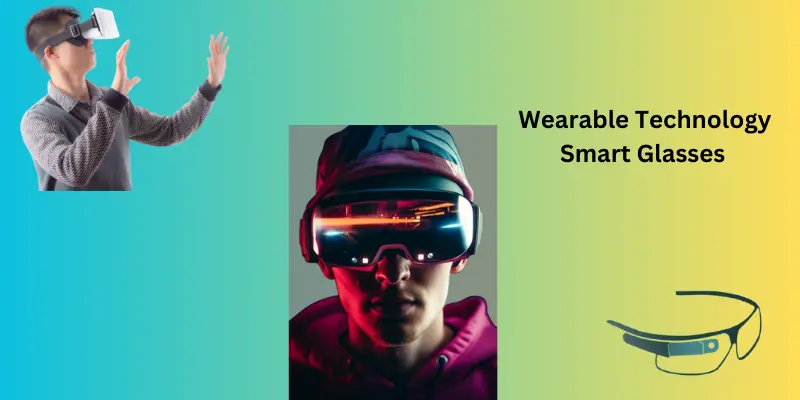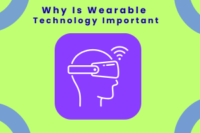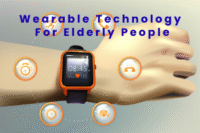Wearable Technology Smart Glasses: Future & Benefits
Published: 02 Feb 2025
Wearable technology smart glasses are a cool new trend in wearable technology. They look like regular glasses but have built-in tech like tiny screens, cameras, and sensors. They can show you information, take photos, give directions, or even translate languages right in front of your eyes. Think of them as a mix between glasses and a smartphone, making everyday tasks easier and more fun. As tech gets better, smart glasses are becoming more popular for work, fitness, and entertainment.
Wearable technology smart glasses are designed to provide hands-free access to digital information, enhancing convenience and efficiency. They improve daily life by enabling real-time navigation, notifications, augmented reality experiences, and voice-controlled assistance, making tasks easier at work, home, and on the go.

Smart Glasses How Do They Work
Smart glasses work by combining advanced hardware and connectivity features to deliver a seamless experience. Here’s a simple breakdown:
Hardware Components:
- Display: Tiny screens (often near the lenses) show information like notifications, maps, or videos. Some use augmented reality (AR) to overlay digital images onto the real world.
- Sensors: Accelerometers, gyroscopes, and GPS track movement, orientation, and location, helping the glasses respond to your actions.
- Camera: Built-in cameras can take photos, record videos, or scan the environment for AR features.
- Microphone and Speakers: Allow voice commands, calls, and audio feedback without needing headphones.
- Processor: A small chip (like in smartphones) powers the glasses, running apps and processing data.
Connectivity:
- Wi-Fi/Bluetooth: Connects to the internet or pairs with your smartphone for apps, calls, and updates.
- AI Integration: Artificial intelligence helps with tasks like voice recognition, language translation, or personalized recommendations.
Together, these components make smart glasses a hands-free, interactive tool for everyday life.
Top Smart Glasses in the Market
Here’s a quick look at the smart glasses information:
1. Wearable Technology Google Glass:
Google Glass is one of the first and most well-known examples of wearable technology. It’s a pair of wearable technology smart glasses designed to bring technology closer to your eyes, literally. Here’s a simple breakdown:
- It’s a wearable computer built into glasses.
- It has a small display above the right eye, a camera, a microphone, and a touchpad on the side.
- It connects to your phone or Wi-Fi to give you information hands-free.
2. Meta Ray-Ban Smart Glasses:
- A stylish collaboration between Meta (Facebook) and Ray-Ban.
- Includes cameras, speakers, and a microphone for photos, videos, and calls.
- Designed for everyday wear with a focus on social sharing.
3. Vuzix Blade:
- Known for its sleek design and AR features.
- Offers a color display, voice control, and app integration.
- Popular for both consumer and enterprise use.
4. Other Emerging Brands:
- Nreal Air: Lightweight AR glasses for gaming and entertainment.
- Snap Spectacles: Focused on social media and content creation.
- Epson Moverio: AR glasses for industrial and entertainment use.
These smart glasses information cater to different needs, from work and productivity to fashion and fun, making them a versatile choice in wearable tech.
Smart Glasses Purpose
The purpose of smart glasses is to make life easier and more connected by combining technology with everyday eyewear. They help you:
- Hands-free convenience
- Augmented reality applications
- Improved productivity and accessibility
- Health and fitness tracking
In short, smart glasses’ purpose is to simplify tasks, save time, and add a touch of futuristic convenience to your day!
Challenges and Limitations
Here are some disadvantages of smart glasses explained in simple terms:
1. High Cost:
- Smart glasses are often expensive, making them less accessible for many people.
- Prices can range from hundreds to thousands of dollars, depending on features.
2. Privacy Concerns:
- Built-in cameras and microphones raise concerns about recording without consent.
- Users and bystanders may feel uncomfortable about being filmed or monitored.
3. Limited Battery Life:
- Most smart glasses battery life is very short (a few hours), requiring frequent charging.
- Heavy use of features like AR or video recording drains the battery faster.
4. Comfort and Usability Issues:
- Some models can be bulky or heavy, causing discomfort during long-term wear.
- Small displays and touch controls may not always be user-friendly.
These disadvantages of smart glasses need to be addressed for them to become more mainstream and widely adopted.
Real-Life Applications
Smart glasses are being used in various real-life applications, making tasks easier and more efficient across different fields:
1. Workplace Efficiency:
- Warehouse Operations: Workers use smart glasses to scan barcodes, track inventory, and receive real-time instructions, improving speed and accuracy.
- Remote Assistance: Technicians can get live guidance from experts through AR overlays, reducing downtime and errors.
2. Smart Glasses in Healthcare:
Smart glasses are making a big impact in healthcare by improving how doctors, nurses, and patients interact with technology. Here’s how they’re being used:
- Assisting Surgeons: Smart glasses provide surgeons with vital patient data, 3D imaging, or step-by-step guidance during procedures.
- Patient Monitoring: Doctors and nurses can access patient records and monitor vitals hands-free, improving care efficiency.
3. Education and Training:
- AR Learning Experiences: Students can explore interactive 3D models, virtual labs, or historical reconstructions for immersive learning.
- On-the-Job Training: Workers in industries like manufacturing or aviation use AR glasses to learn complex tasks in a safe, guided environment.
4. Entertainment and Gaming:
- Immersive Gaming: AR glasses create interactive gaming experiences by blending digital elements with the real world.
- Media Consumption: Users can watch videos, browse social media, or stream content on a virtual screen, enhancing entertainment on the go.
These applications show how smart glasses are transforming industries and everyday life with their innovative capabilities.
Smart Glasses In Pakistan
Smart glasses are slowly gaining attention in Pakistan as wearable technology becomes more popular worldwide. While they’re not yet mainstream, here’s how they’re making an impact and what the future might hold.
Current Status: Smart glasses like Google Glass and Ray-Ban Stories are available in Pakistan through online platforms and tech stores but remain niche due to high costs and limited awareness.
Potential Uses: They can revolutionize healthcare (remote consultations), education (interactive learning), tourism (AR-guided tours), and industries (training, inventory management).Challenges: High prices, limited internet connectivity, privacy concerns, and low awareness hinder widespread adoption.
Future of Smart Glasses
The future of smart glasses looks exciting, with advancements and innovations poised to transform how we interact with technology. Here’s what to expect:
Expected Technological Advancements:
- Improved Displays: Thinner, lighter, and higher-resolution screens for better AR and VR experiences.
- Longer Battery Life: More efficient power systems or alternative energy sources like solar charging.
- Enhanced AI: Smarter voice assistants, real-time language translation, and personalized recommendations.
- Better Design: Sleeker, more fashionable frames that look like regular glasses.
Potential Impact on Industries:
- Healthcare: AI-powered diagnostics, remote surgeries, and real-time patient data access.
- Retail: Virtual try-ons, personalized shopping experiences, and AR product demonstrations.
- Education: Immersive learning with 3D models, virtual field trips, and interactive lessons.
- Manufacturing: Hands-free assembly instructions, quality control, and remote expert support.
Innovations Like AI-Powered Interactions:
- Context-Aware Assistance: Smart glasses will understand your surroundings and offer relevant information (e.g., navigation tips or restaurant reviews).
- Gesture and Eye Tracking: Control glasses with hand gestures or eye movements for a more intuitive experience.
- Emotion Recognition: AI could analyze facial expressions to provide tailored responses or support.
As these technologies evolve, smart glasses will become more integrated into daily life, revolutionizing industries and enhancing how we work, learn, and play.
| Conclusion |
|---|
|
Wearable technology smart glasses are a big step forward in wearable tech. They mix cool features like tiny screens, cameras, and AI to help you in everyday life. They can make work easier, improve learning, assist doctors, and even make gaming more fun. As they get better, smart glasses will become cheaper, lighter, and more useful. Whether you want to stay organized, learn in new ways, or just enjoy the latest tech, smart glasses could be a great fit for your life. Think about how they might help you or make things more fun. The future of tech is here, and smart glasses are a big part of it! |
FAQs
Yes, wearable technology smart glasses are generally safe for daily use, but there are some concerns. Extended screen time can cause eye strain, and prolonged Bluetooth or Wi-Fi exposure raises minor health debates. Also, wearing them while driving or walking can be distracting. If used responsibly, they are safe for most people.
The battery life of smart glasses depends on the model and usage. Most last between 2 to 10 hours on a full charge. Basic models with limited features last longer, while high-end AR glasses drain faster due to displays and sensors. Charging frequency depends on usage habits.
No, wearable technology smart glasses cannot fully replace smartphones yet. They offer hands-free access to calls, notifications, and AR features, but they have limited apps, smaller displays, and shorter battery life. Smartphones are still essential for complex tasks like typing, browsing, and gaming.

- Be Respectful
- Stay Relevant
- Stay Positive
- True Feedback
- Encourage Discussion
- Avoid Spamming
- No Fake News
- Don't Copy-Paste
- No Personal Attacks

- Be Respectful
- Stay Relevant
- Stay Positive
- True Feedback
- Encourage Discussion
- Avoid Spamming
- No Fake News
- Don't Copy-Paste
- No Personal Attacks



